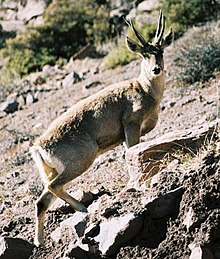Huemul (zoology)
| Hippocamelus | |
|---|---|
 |
|
| The taruca | |
| Scientific classification | |
| Kingdom: | Animalia |
| Phylum: | Chordata |
| Class: | Mammalia |
| Order: | Artiodactyla |
| Family: | Cervidae |
| Subfamily: | Capreolinae |
| Genus: |
Hippocamelus Leuckart, 1816 |
| Species | |
|
Hippocamelus bisulcus Molina, 1782 |
|
Hippocamelus bisulcus Molina, 1782
Hippocamelus antisensis d'Orbigny, 1834
Hippocamelus is a genus of Cervidae, the deer family. It comprises two Andean species, commonly known as the huemul (from the Mapuche language), and the taruca.
Both species have a stocky, thick, and short-legged body. They live at high altitudes in the summer, then move down the mountains in the fall and spend the winter in sheltered forested valleys. Areas with fresh water are preferred. They are herbivores that feed primarily on herbaceous plants and shrubs as well as sedges, lichens, and grasses found between the rocks on high peaks. They are active during daytime and have a lifespan of about ten years.
The huemul (Hippocamelus bisulcus), also known as the South Andean deer, is found in Chile and Argentina. Huemuls live in groups of varying size, typically of two or three individuals, but sometimes as many as eleven. In the past, groups of over a hundred deer were reported. Groups are made up of a female and her young, while males are often alone.
Huemul occur in several national parks in Chile and neighbouring parts of Argentina and have been on the Endangered list since 1996. They are endangered primarily due to human impacts such as deforestation, habitat fragmentation by roads, introduction of non-native mammals such as farm animals, and poaching. They are in a classic "extinction spiral" marked by increasingly small, isolated populations.
The huemul is, along with the condor, the national animal of Chile.
...
Wikipedia
